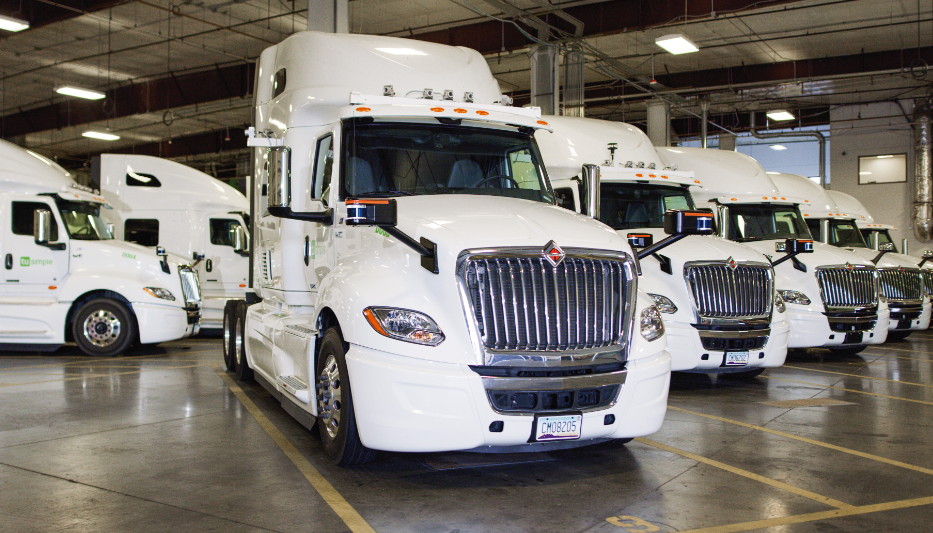All
The Race for Self-Driving Big Rigs
by Ed Burke and Kelly Burke, Dennis K. Burke Inc.

Our old friend “Otto” has retired, but others are picking up where he left off
In 2016, we wrote about Otto, the autonomous truck that completed the first commercial shipment without a driver behind the wheel. The Volvo 18-wheeler delivered 2,000 cases of Budweiser on a 120-mile trip through Colorado. A professional driver was in the cab, prepared to assist if problems arose, but at no point did he need to take over.
Otto, which was owned by Uber, moved fast to commercialize self-driving kits, including cameras, laser-imaging LiDAR sensors, and radar, as well as software and an on-board computer that would allow existing 18-wheelers to operate on highways without human intervention. But they were still working on basics like acceleration, braking and improving lane control. Longer-term goals had included predicting how other drivers were likely to behave, navigating construction zones, and dealing with hazards like sudden bad weather.
In 2018, Uber announced it would shift its focus to self-driving cars, but several other tech companies are headed in the opposite direction.
Why Trucks, Not Cars
Over the last five years, it became more and more obvious that self-driving cars would take longer than expected. That’s one reason the industry turned their attention to long-haul trucking. It’s become a high-stakes race to see who will emerge as the new kings of the road.
Autonomous trucking companies have been quietly testing their prototypes on public roadways. The competition is fierce, so much of their technology and data are kept secret.
Sensor gear has improved significantly in the past few years. There’s now a network of sensors, cameras, and radar devices strapped to the outside of the rig, all of it hardwired to an internal AI supercomputer that drives the truck.
In the “depot-to-depot” model, the on-board computer would cover the long and relatively simple stretches of interstate driving and leave the tricky surface streets to human drivers who would take over at highway off ramps.
It’s likely that safety drivers will remain in cabs for years to come as companies hone their sensor technology and train their software for every highway scenario.
Leading the Way
There are more companies getting into the game now, and a few have a good shot at making it to the finish line – TuSimple, Waymo and Aurora.
TuSimple has been around since 2015, so they had a bit of a jump on the competition. This spring, TuSimple was the first autonomous trucking company to go public, raising a billion dollars. The company has ambitious plans to expand their trucking routes in the Southwest and Texas, to Florida, Tennessee and the Carolinas.
At a TuSimple facility just outside of Tuscon, Arizona, a fleet of 50 autonomous rigs (worth about $12 million) are on the move. Amazon, UPS, and the U.S. Postal Service ship freight with TuSimple trucks.
For now, TuSimple has safety operators in the cab, but expect their first driver-out demonstration runs on public highways this year.
The TuSimple system can see forward over a half mile. It can operate in the rain, day and night, and they’re working on driving in the snow.
TuSimple collects a lot of data as it maps more and more routes across the Southwest. They also have a fleet of autonomous trucks in Shanghai, China. The data collected by each truck, along every mile is uploaded and used to perfect performance on the road.
Waymo, launched its trucking division, Via, in 2017. Waymo vehicles have covered more than 20 million miles on public roads since 2008 – experience that may pay off in trucking. Aurora Innovation Inc. was also launched in 2017, and decided to focus its efforts on bringing a trucking product to market before branching into ride-hailing. The logic is simple: highways are easier to navigate than city streets, and cargo is less demanding than human passengers.
Down the Road
A driverless truck can get coast to coast in two days, not four, only stopping to refuel along the way. A route is mapped and programmed before the run, and that’s about it. The rest is up to the computer, which makes 20 decisions per second about what to do on the road.
Driverless trucks also pose fewer dangers. They don’t speed, text, or drive under the influence, and don’t need sleep (each a common cause of accidents).
For tech companies, go-anywhere, full autonomy is the ultimate goal, but that requires tackling some pretty tough things like parking, dense urban streets, and handling erratic behavior by pedestrians and drivers. At least for the foreseeable future, drivers will remain an essential part of the system.
Ed and Kelly Burke are respectively, Chairman of the Board and Senior Marketing Manager at fuel distributor Dennis K. Burke Inc. They can be reached at 617-884-7800 or ed.burke@burkeoil.com and kelly.burke@burkeoil.com.
Related Posts
 What’s Next in Boiler Technology
What’s Next in Boiler Technology
Posted on June 25, 2025
 Data Delivers!
Data Delivers!
Posted on April 28, 2025
 Harnessing Payment Data to Increase Profitability
Harnessing Payment Data to Increase Profitability
Posted on March 10, 2025
 DeepSeek Is Our AI Wake-Up Call
DeepSeek Is Our AI Wake-Up Call
Posted on March 10, 2025
Enter your email to receive important news and article updates.
